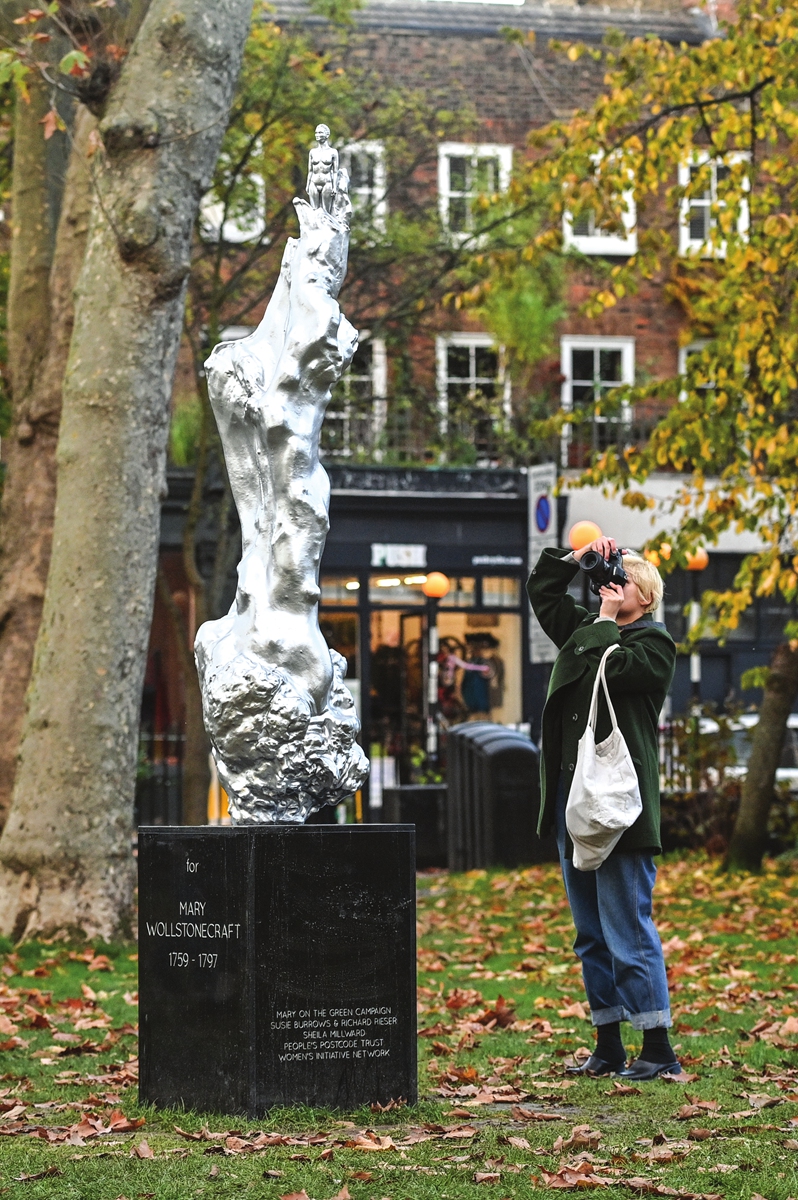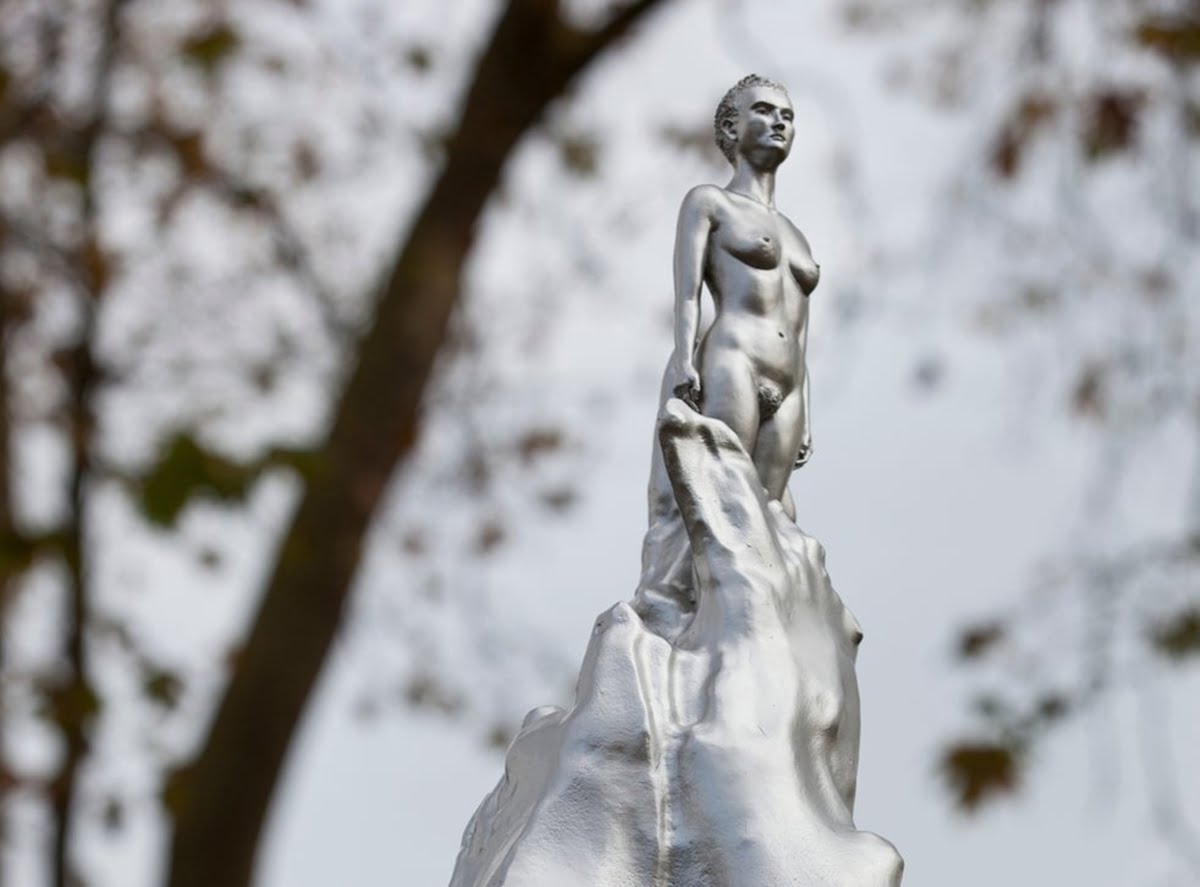Mary Wollstonecraft , the pioneer of feminism has been stripped off all her accoutrements. She has been made to abandon all additional coverings which were likely indispensable to obscure her eighteenth century modesty from us Z generation population who by now should have realised that scanty clothing does not give one a pass to disrespect women with less clothes on. The robed figure of Mary has been disrobed completely to reveal a nude figure of a not so matronly Mary Wollstonecraft looking ravishingly toned, erected bang in the middle of Newington Green, North London.

Also read: An Enquiry Into Internalised Male Gaze: Whose Camera Is It Anyway?
And all this disrobing was done in the name of feminism.
However, some critics do not seem to think so. For them Mary Wollstonecraft, the stalwart of feminism, stands denigrated if she sheds her apparel — even if “she” is an inanimate statue. They want to coax Mary Wollstonecraft into putting her clothes on once again, only then will she be worthy of their respect. In effect, they seem to be saying that every naked or semi nude female on the beach or at other places should be disrespected and be promptly asked to put her clothes on if she wants to command their respect.
For some critics, Mary Wollstonecraft, the stalwart of feminism, stands denigrated if she sheds her apparel — even if “she” is an inanimate statue. In effect, they seem to be saying that every naked or semi nude female on the beach or at other places should be disrespected.
That the naked female body is a passive symbol of female power is a belief upheld by women. That this belief becomes a myth for the other half of humanity is something that feminists often forget. Does this inertia serve to subdue feminism? Should not feminism be all about honouring the female gaze, instead of culling it at the behest of the male gaze. A nude statue of Mary Wollstonecraft has the potential to be radically subversive only if it is seen through the correct lens — the lens of change, progress and radical subversion. The line between female power and female objectification could be easily trangressed. Yet, is it necessary to curb the display of female power just because men may not see it through the same lens?
The critics of Maggie Hambling’s creation should not advocate to keep Mary Wollstonecraft in the trappings of skirts and corsets. Art is only effective if it possesses the radical power to advocate for change. A Mary Wollstonecraft in a gown would be just another portrait of her in a dull, antiquated London museum. A nude version of Mary Wollstonecraft, on the other hand, has the potential to induce changes in the way society looks at women with “less clothes on”. Critics have said that this blatant depiction would likely engender female objectification, thus defeating the very purpose of feminism. The point of contention here should not be what it engenders but what in fact it should not engender, namely female objectification. What Mary Wollstonecraft’s statue should in fact engender is deep introspection by men if and when they do in fact end up lusting after a naked statue of an important political figure in feminist history while also questioning her credibility without her clothes. What’s happening instead is completely opposite: with both men and women criticising the sculptor Maggie Hamblings for questioning the status quo through the naked Mary Wollstonecraft statue.
Her statue should serve as a reminder to men that a naked woman or a woman who indulges in “skin revelation” is a human being with her own agency who chooses to wear what she does to not necessarily turn men on. She may have chosen what she wears or what she does not wear on the basis of her own comfort level or her aesthetic taste or simply because she felt like it for no reason at all. The subversive ability of Mary Wollstonecraft’s statue can serve as a “Statue of Femininity”, much like the Statue of Liberty in New York . It can serve as a reminder to men that great all women, just like Mary Wollstonecraft DESERVE respect without their clothes on as well as with them.
In other words, Mary Wollstonecraft with clothes on is a cause for celebration while the same person without clothes is worthy of little or no respect at all just because men are so scared of becoming tamed by the power of a woman’s sexuality.
Also read: The Feminist Film: Defying The Male Gaze Of Celluloid
The critics of Mary Wollstonecraft’s naked statue have laid bare their suppressed bigotry. In denigrating a naked woman, they have in effect said that a woman with less clothes deserves less respect, never mind the fact the woman in question is among the most important women in feminist history. In other words, Mary Wollstonecraft with clothes on is a cause for celebration while the same person without clothes is worthy of little or no respect at all just because men are so scared of becoming tamed by the power of a woman’s sexuality.
The only fathomable reason for this unprecedented fear and backlash is the power of female sexuality and the threat it poses to male notions of superiority.
Harsahej Mann is a 20 year old, currently pursuing an history honours degree. She loves reading and writing. Her creative writing pieces have been published by national newspapers like The Tribune, The Literary Digest and The Raw Whispers Magazine. You can read her work on https://sayingdotpress.wordpress.com/ She can be found on Instagram.
Featured Image Source: The Independent





author needs to understand why there aren’t any naked statues of gandhi or mandela instead of persuading personal sentiments. disappointing lack of critical analysis. her nakedness isn’t the issue here. everything is not about sex positivity but reducing a woman to her nakedness is not a very feminist take at all.
The entire point of art to induce change lies in it being radical and subversive , if it supports convention then it is not art , then it is merely a homage to a historical figure . Also Gandhi and Mandela have been venerated in their own ways . Men and women ( sadly ) should look at her naked statue and remind each other that a naked female body commands respect and dignity and that to mark this respect that has been long due to her a naked statue of the stalwart of feminism has been built . By critiquing her naked statue you are in effect contributing towards maintaining this vile status quo . I know how it feels when men objectify a woman and it is a personal dilemma to choose place appropriate clothes everyday so as not to be objectified and believe me it really Drains me of my energy .Incidentally Mary Wollstonecraft wrote about the same thing in her treaties. Also , Mary Wollstonecraft had a child outside of wedlock in eighteenth century England ( she was surely ahead of her times ) , so I don’t see why anyone should force her statue to wear “ Victorian corsets” when the whole point of the statue is to help people change their unhealthy mindset which forces young women like me to change multiple clothes each day . Why should we take preventive measures when we live in an age where we must find a cure . A subversive statue is the beginning . I’am in no way a radical feminist who advocates nudity but definitely I do not support the internalisation of false notions of Victorian morality in art because as I said the purpose of art is to challenge convention . I’am not saying that women should shed their apparel but I strongly believe that a subversive statue like this will remind society that women with less clothes on can be strong and intellectual like Mary Wollstonecraft. I think you should open your mind to change and progress and learn to look at what you deem to be “ perverted” and disrespectful through the lens of change .